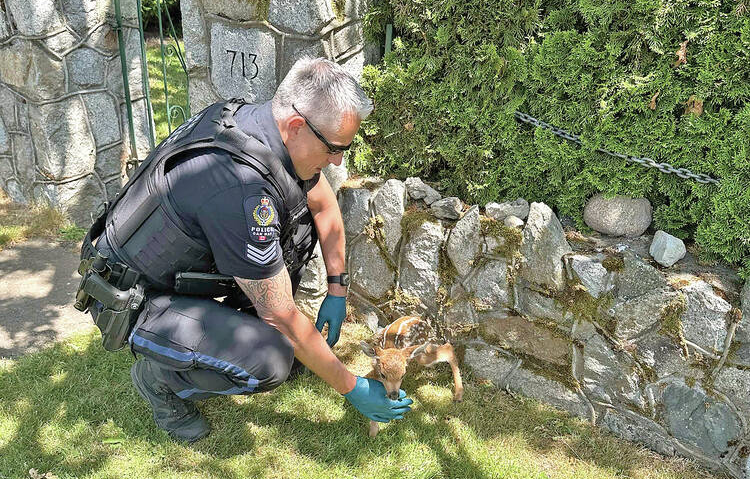Fawns are everywhere these days as the region’s booming black-tail deer population gives birth and mothers start leaving their babies for extended periods.
The general rule, according to Breanne Beckett, senior manager for the B.C. SPCA WildARC facility in Metchosin, is to leave the fawns alone. Mothers are out feeding and will return to feed and retrieve them, she says.
But there are extraordinary situations where the fawns may be injured or in danger, which was the case last Wednesday when Oak Bay police found one under a parked vehicle at Oliver Street and Central Avenue.
Sgt. Kevin Diachina used gloves to move the fawn out of harm’s way to a nearby sidewalk boulevard in the shade, where the mother and baby could be reunited safely. The department then contacted the B.C. Conservation Officer’s Service.
A resident had observed a doe walking around vehicles and into traffic trying to get to her baby, and reported it to police.
Police said there was concern the mother deer could be struck by a passing car while she was trying to get the fawn off the roadway. Police removed the very young fawn from under the parked vehicle and off the roadway.
The B.C. SPCA says every year, wildlife rehabilitators end up caring for healthy fawns that were thought to be orphaned.
Beckett said it’s normal for a mother deer to leave a fawn alone for extended periods. They come back only a few times a day to feed the baby, who waits quietly while hiding from predators.
She said if you find a fawn lying quietly, don’t disturb them. Check on the fawn from a distance for the next 24 hours for any signs of injury or distress. The mother will likely return and move the baby to a new spot.
If the fawn has not moved after 24 hours, starts to cry, is wandering aimlessly or looks injured, contact the B.C. SPCA at 1-855-622-7722 right away.
If the fawn is in an unsafe location, move them gently using gloves to a safe spot very close by so they won’t get hurt. The gloves will help mask your scent, said Beckett.
The WildARC facility in Metchosin currently has four fawns in care. Beckett said several are raised or nursed back to health over the summer months and usually released in a group in the fall.
>>> To comment on this article, write a letter to the editor: [email protected]



